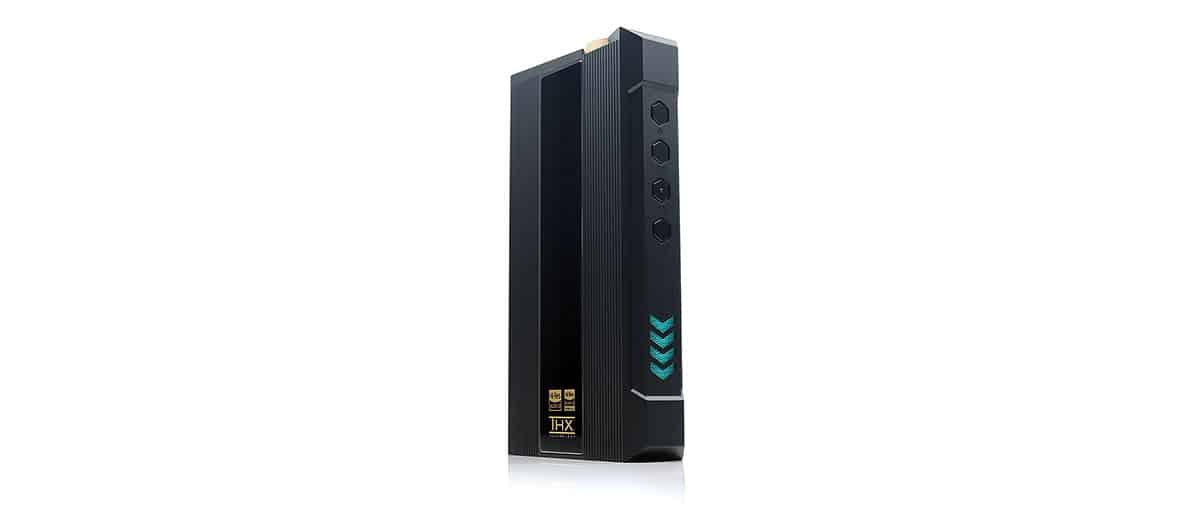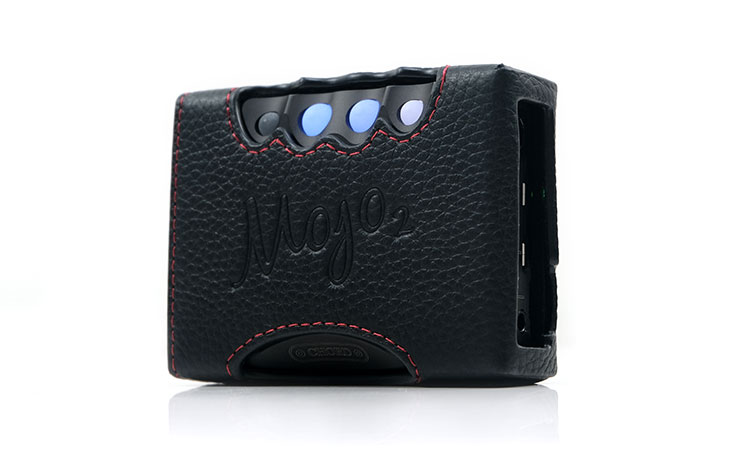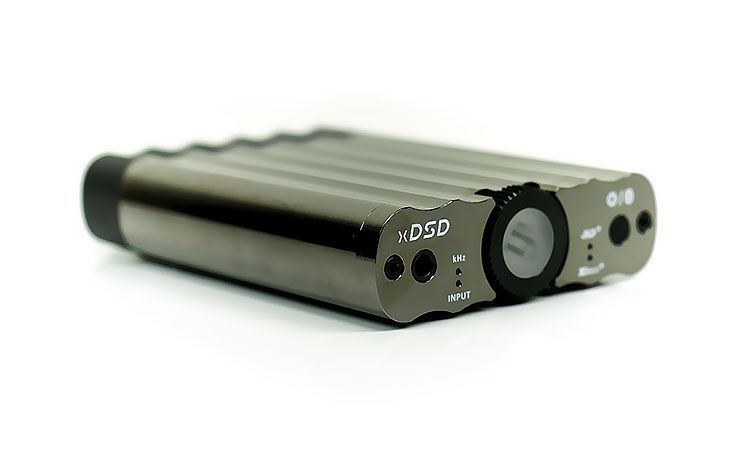Select Comparisons
FiiO M17
Despite being a more expensive DAP, we wanted to primarily look at the wired and wireless performance overlap given both devices are built around the same topology and chipsets. You can find our full M17 review here from earlier in the year.
$1799
Technical
Both the Q7 and the M17 use a THX amplification topology combined with an ES9038PRO dac chipset implementation. However, it is not an exact duplicate with the biggest deviation inside the Q7 being the use of a single 4-channel ES9038PRO design as opposed to the M17’s 8-channel dual-channel alternative.
Still, the decoding of both is the same with the two devices able to handle up to native DSD512 via USB-DAC as well as PCM up to 32BIT/768kHz. MQA unfolding on both is set at 8X so the max here is 384kHz on a 44.1kHz folded sample size.
Both devices also use the same BT5.0 capable QCC5124 chipset so wireless codec decoding up to LDAC 24BIT/96kHz is possible with support for the full gamut of aptX versions including Adaptive, HD, and LL down to SBC and AAC.
The amplification side is almost like-for-like with both the Q7 and the M17 using a dual THX AAA 788+ amplifier setup with a maximum of 3W into 32Ω balanced using the DC power mode and 1.5W into the same load on the pure battery mode.
The numbers follow the same pattern for SE at 1.5W and 750mW respectively so the only differences I can see are more nuanced and could be a benchmarking adjustment such as the output impedance increasing by 0.2Ω across the board.
The Q7 is listed as having a stronger voltage swing though at 10V switching from the battery to DC mode as opposed to 8V on the M17.
Design
Very much a shared mech-inspired design language, dimensions, and weight for both with the only changes coming from accommodating their niche purpose.
By that I mean the M17 is a DAP so we have a large LCD screen for the Android OS on the front panel. No Android and no need for the large screen on the Q7 so instead we get an adaptation of the BTR7 1.5″ TFT panel top and center.
Having said that some cost-related changes are introduced with the Q7 design version. For example, that 3D diamond-like back plate on the M17 is replaced by a plainer plastic back panel on the Q7.
Other changes include the bottom panel digital I/O which I find to be more comprehensive with the Q7, with the inclusion of that optical input. Again, there is a needs-basis here with essential DAP features for the M17 with the split USB for OTG purposes and the additional local memory card slot.
Since the Q7 has no real in-depth OS, the battery and DC modes as well as the charging modes are all mechanical switches controlled on the base panel. You do get the gold multi-functional potentiometer which the M17 does not use.
You also get a lot more physical button controls on the M17 combined with a much more in-depth OS experience. The wider connectivity platforms open up a huge range of streaming possibilities. You can stream with the Q7, by the way, but only via BT from another source such as a smartphone which is lossy compared to a good WiFi connection.
Performance
For this assessment, I used the Noble Audio Viking Ragnar combined with a Huawei Mate Xs 2 smartphone and HiBy Music’s Exclusive HQ USB Audio Access mode for the Q7.
For the M17, it was straight out of the 4.4mm balanced by also using the same HiBy Music settings. Both the Q7 and M17 were on the slow filter with a low gain setting.
I was honestly expecting these two to sound exactly the same but perhaps due to the OTG source or the single ES9038PRO as opposed to the M17’s dual chipset, I found the Q7 just a shade softer sounding, especially through the upper mids and treble.
I have a few tracks that I find to be inherently bright on the mix with a slight emphasis on sibilance with soprano-pitched vocals. The Viking Ragnar is very adept at picking up even the subtlest of changes in this sibilant emphasis over the upper mids. It can sound vivid, soft, or slightly metallic depending on the source.
In the case of the M17, the sibilance was more prevalent on the leading edges but not overly metallic, rather more accurate to the recording. Whereas with the Q7 the leading edge felt somewhat softer and not quite as well defined with a generally more forgiving performance paired with the Ragnar.
If I am being put on the spot, and just a slight continuation from the above point that the Q7 seems very marginally more relaxed and not quite as vivid or holographic in its delivery as the M17 but you would be hard-pressed to notice it unless you have a super revealing monitor.
Again, that might be the dual DAC advantage of the M17 at play because, in all other aspects, these two devices are almost the same in terms of a generally dynamic, clean timbre, and punchy sound quality.
Chord Electronics Mojo 2
$775 (£449 UK)
The Mojo 2 pricing is a bit all over the place globally though in the US it’s almost the same as the Q7 which makes it one of FiiO’s major competitors. You can read our Mojo 2 review from earlier in the year here.
Technical
Quite a plethora of differences here internally. The Q7 uses a single delta-sigma ES9038PRO DAC chipset whereas the DAC inside the Mojo 2 is in-house designed and is based on the FPGA-driven WTA, (Watts Transient Aligned), filter at the heart of its decoding engine.
The Mojo 2 does still retain the original Mojo’s Xilinx Artix 7 FPGA chipset, (XC7A15T), which is the same board used inside the Hugo 2 with 40,960 taps using 40 DSP cores which is now that little bit closer to the performance level of the Hugo 2, (49,152).
There are some processing differences also with the Q7 capable of up to DSD512 natively and PMC 32BIT/768kHz and the Mojo 2 a bit behind at PCM 32BIT/768kHz and DSD256. The Mojo 2 also does not offer MQA which is a company principle rather than an inability. BT is also missing on the Mojo 2.
The Mojo 2 uses Class A amplification compared to the THX amplifier inside the Q7 and their power on demand is quite different. The Mojo 2 is a dual SE 3.5mm output at up to 600MW into a 30Ω load down to 90mW into 300Ω.
The Q7 will give you a lot more at up to 3W DC powered and 1.5W on the battery on a 32Ω load for balanced but much closer at 750mW unbalanced using the battery. At 300Ω SE the difference is not huge either but still in favor of the Q7 with a stronger 130mW output.
Design
The pros and cons of the design and feature differences between these two are largely going to be contextual to how you want to use them.
If it’s about pure portability then it is the Mojo2 which is massively smaller and lighter and very much a smartphone companion. If you want to switch hit between a desktop system and some transportability then the Q7 is the better choice.
The build quality on both is excellent with the Mojo 2 perhaps just shading it in terms of smooth finishing but this is more about design language choices rather than imperfections. The LCD screen and multi-function button system of the Q7 are more intuitive than the orb UI of the Mojo 2 for most though once learned it’s easy enough to manage.
The features they do share include optical and coaxial digital input capability as well as operating as a USB-DAC. What the Mojo 2 lacks is a vast array of analog outputs both balanced and SE, and a proper line out. Again, the price of going compact in a way or the drawback of going big in the case of the Q7.
The Q7 really lacks that excellent Mojo 2 DSP system. You can pull from the ES9038PRo digital filters via the Q7 menu but it’s nowhere near as transformational as the Mojo 2 UHD DSP suite.
Surprisingly, the battery life is a little bit better on the Q7 with the Mojo 2 at 8 hours and the Q7 capable of 10-11 hours under the right conditions.
Performance
For this comparison, we went with the UM MEXT with both the Mojo 2 and the Q7 SE output and hooked up in USB-DAC mode to the PC with Roon as the media software player.
Some clear-cut differences between these two amp/DACs. The first is the timbre, just a slight bit more warmth in the Mojo 2 though it is not a warm amplifier per se, rather the Q7 seems to offer more contrast and a slightly stronger or more forward treble overtone.
The resulting note timbre is thus more natural to my ear from the Mojo 2 with the Q7 lifting the upper harmonic order a bit more, shifting percussion timbre to a slightly brighter overtone with more contrast as a result.
Sibilance is also just a shade more emphasized with the Q7/MEXT pairing whereas the Mojo 2 is the gentile and smoother of the two for the same vocal performances.
The Q7’s stronger treble presence will bring airy spatial cues or high-frequency notes a bit more to the fore and add some additional sparkle to the presentation. That might create a stronger perception of staging headroom over the Mojo 2’s slightly more relaxed treatment.
Whereas the Mojo 2 really excels in digging a little deeper or at least yielding a denser sub-bass quality that injects a stronger fundamental when called upon. You could argue the harmonic balance is a little more even-harmonic weighted with the Chord/MEXT pairing.
iFi Audio xDSD
$399
Sadly, I personally do not have the Gryphon version of the xDSD which would have been ideal but the original xDSD is still for sale, and in places like Amazon you can grab it for $100 less than SRP. You can read our original review of the xDSD here.
Technical
The xDSD uses an older but still quite popular Burr-Brown PCM1793 Multibit hybrid DAC architecture. It is nowhere near as advanced as the ES9038PRO inside the Q7 but does tend to deliver a timbre that has garnered a wide fanbase.
Decoding is as competitive as the Q7 with up to PCM 32BIT/768kHz and native DSD512, (via USB-DAC) and yes, it will also handle MQA but at a lower X4 rate. That means unfolding up to 192kHz as opposed to 384kHz.
Both offer Bluetooth receiving though understandably the xDSD is a grade lower given it’s an older unit. You get a BT4.0 capable Qualcomm CSR8645 with a maximum of aptX 16BIT/44.1kHz as opposed to the Q7’s more modern Bt5.0 and LDAC top tier 24BIT/96kHz capability.
The xDSD incorporates a customized opamp solution called an OV4627 ultra-low noise FET input Op-Amp as opposed to the dual THX AAA 788+ topology inside the Q7.
The implementation is technically SE and balanced for the output but instead of 4.4mm, it uses iFi Audio’s S-balanced 4-pole system which is a bit niche.
The xDSD lacks a wide range of analog outputs so most will revert to using SE and here you have a reasonable 500mW into a 16Ω load, perhaps higher for 32Ω but nothing quite like the X7’s 750mW SE and 1.5W balanced when both are using a battery, never mind the 3W balanced in DC mode.
Design
Like the Mojo 2, the xDSD is much smaller and lighter compared to the Q7 and should be seen primarily as a portable device rather than the transportable desktop replacement that FiiO has envisaged.
Now, some of the I/O of the xDSD is a bit clunky and has been updated in the Gryphon version since then. For example, both the Q7 and the xDSD will give you a USB-DAC and OTG capability but it’s via a micro-USB and a sunken female USB-A port requiring an older style OTG male USB-A adaptor.
Charging is also via micro-USB as opposed to the Q7’s modern single USB-C port that works with both OTG, charging, and data transfer. A much simpler solution.
Digital I/O is also more limiting on the xDSD with a single SPDIF as opposed to the more comprehensive separate coaxial and optical ports on the Q7. Granted, the size of the Q7 allows FiiO more flexibility to bring in a lot more options and price it accordingly with a similarly wider range of analog outputs on the front panel.
Mind you, the DSP on the xDSD is really good, better than the Q7 digital filter options. I do enjoy the xBass and 3D+ options on the xDSD and they bring a lot more to the table in terms of staging and low-end adjustments that you can hear during playback.
Performance
The setup for this comparison is a set of Empire Ears Valkyrie MKII and both the xDSD and the Q7 hooked up to Roon and a PC using FLAC and TIDAL integrated for MQA.
In every aspect, bar one, the Q7 bests the xDSD. I include notably dynamic range and staging complexity where the Q7 sounds more resolving with better instrumental separation and improved headroom.
The xDSD sounds more compressed, less airy, and more center-focused. It lacks the resolving capability of the Q7 for micro-detail. You can expand the staging width of the xDSD quite well with the 3D+ DSP but the center image still lacks a bit of separation for me creating a wider 2D quality rather than an improved 3D profile.
That one aspect the xDSD does have some fun with? Bass. This is why I picked the Valkyrie MKII because if there is any strength in the low-end response you will hear it 10-fold from the bottom-weighted Valkyrie MKII presentation.
The xDSD delivers a lot more low-end density and bloom in its default mode and is complete overkill with the XBass mode turned on. It sounds huge and will definitely impress the casual basshead listener with such an overt coloration on the lows.
The Q7 does not come anywhere near that level or volume but it does not really need to. What it offers is a superior definition and improved layering. You might not get the warmth or the amplitude but you get a far clearer picture of what is happening from the lows of the Valkyrie MKII.
Our Verdict
The FiiO Q7 is a largely faithful reproduction of that robust and exciting sound of the flagship M17 DAP for a much lower price.
For those who felt the M17 was out of their budget and did not want to be tied to one spot in the room with the K9 Pro ESS then the Q7 is easily the next best thing in FiiO’s burgeoning lineup.
The only key difference for me might be that switch to the single DAC implementation instead of the M17’s dual which softens up the performance ever so slightly. Other than that, it is a banging tuning with plenty of headroom for both IEM and headphones alike.
Yes, it is big, it’s more transportable than portable, and I honestly have a hard time putting it in the same usage scenario as a Chord Electronics Mojo 2 for example. However, it has just about everything you could want for an affordable heavy-hitting transportable compact desktop amplifier.
The SRP is on point for me, this is an offering drenched in value if you need something with huge power and loads of I/O options in a relatively compact and attractively made form factor.
FiiO Q7 Technical Specifications
- DAC: ESS ES9038PRO
- USB: XMOS XU316
- Amp: THX AAA 788+ x2
- Bluetooth chip: QCC5124
- Weight: 620g
- Dimensions: 158.4 x 88.5 x 28.3mm
- MQA: 8x
- Gain modes: Ultra high (DC mode), Super High, High, Medium, Low
- Screen size: 1.30”
- FiiO control: Yes
- Channel balance: <0.2dB
- Bluetooth 5.0 codecs: AAC, SBC, aptX, aptX LL, aptX adaptive, aptX HD, LDAC
- Maximum supported sampling rate
- USB DAC: 768kHz/32bit, DSD512 (Native)
- Coax: 192kHz/24bit, DSD64 (DOP)
- OPT: 96kHz/24bit
- Recommended headphone impedance PO: 16-150Ω, BAL: 16-300Ω
- USB: Type-C USB 2.0
- Outputs 3.5mm SE, 6.35mm SE, 4.4mm BAL, 2.5mm BAL, 3.5mm SE LO, 4.4mm BAL LO, RCA Coax out
- Inputs Toslink Optical, USB, Bluetooth 5.0
- Power supply: 9V (quick charge), DC 12V/2A
- Battery capacity: 9200mAh lithium polymer battery
- Battery life 3.5mm SE: >11 hours, 4.4mm BAL: >9 hours, 3.5mm SE: >11 hours, 4.4mm BAL: >9 hours
- Maximum output performance parameters
- Output impedance: <1.2Ω
- SNR: >128dB
- Frequency response: 20Hz – 20kHz
- Crosstalk: <114dB
- THD+N: <0.0003%
- Noise floor: <4.5uV






